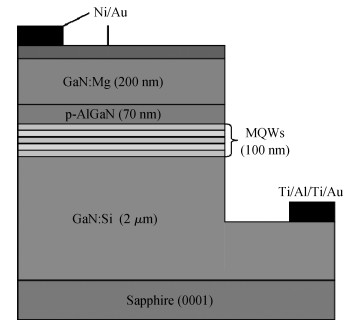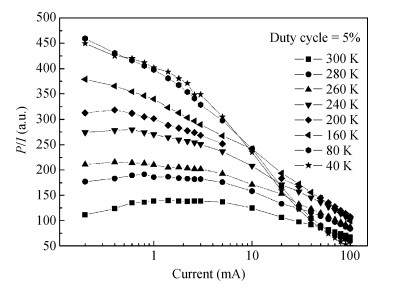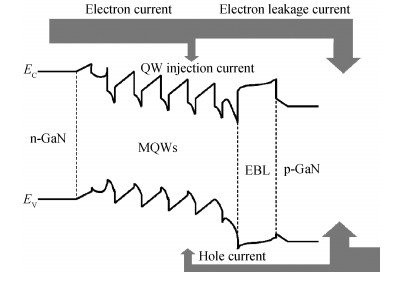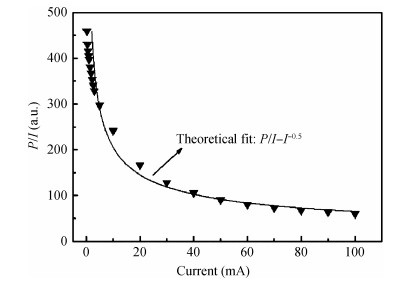| Citation: |
Dawei Yan, Lisha Li, Jian Ren, Fuxue Wang, Guofeng Yang, Shaoqing Xiao, Xiaofeng Gu. Electron-leakage-related low-temperature light emission efficiency behavior in GaN-based blue light-emitting diodes[J]. Journal of Semiconductors, 2014, 35(4): 044007. doi: 10.1088/1674-4926/35/4/044007
****
D W Yan, L S Li, J Ren, F X Wang, G F Yang, S Q Xiao, X F Gu. Electron-leakage-related low-temperature light emission efficiency behavior in GaN-based blue light-emitting diodes[J]. J. Semicond., 2014, 35(4): 044007. doi: 10.1088/1674-4926/35/4/044007.
|
Electron-leakage-related low-temperature light emission efficiency behavior in GaN-based blue light-emitting diodes
DOI: 10.1088/1674-4926/35/4/044007
More Information
-
Abstract
The typical light emission efficiency behaviors of InGaN/GaN multi-quantum well (MQW) blue light-emitting diodes (LEDs) grown on c-plane sapphire substrates are characterized by pulsed current operation mode in the temperature range 40 to 300 K. At temperatures lower than 80 K, the emission efficiency of the LEDs decreases approximately as an inverse square root relationship with drive current. We use an electron leakage model to explain such efficiency droop behavior; that is, the excess electron leakage into the p-side of the LEDs under high forward bias will significantly reduce the injection possibility of holes into the active layer, which in turn leads to a rapid reduction in the radiative recombination efficiency in the MQWs. Combining the electron leakage model and the quasi-neutrality principle in the p-type region, we can readily derive the inverse square root dependent function between the light emission efficiency and the drive current. It appears that the excess electron leakage into the p-type side of the LEDs is primarily responsible for the low-temperature efficiency droop behavior. -
References
[1] Lester S D, Ponce F A, Graford M G, et al. High dislocation densities in high efficiency GaN-based light-emitting diodes. Appl Phys Lett, 1995, 66:1249 doi: 10.1063/1.113252[2] Yang Y, Cao X A, Yan C. Investigation of the nonthermal mechanism of efficiency rolloff in InGaN light-emitting diodes. IEEE Trans Electron Devices, 2008, 55:1771 doi: 10.1109/TED.2008.923561[3] Iveland J, Martinelli L, Peretti J, et al. Direct measurement of auger electrons emitted from a semiconductor light-emitting diode under electrical injection:identification of the dominant mechanism for efficiency droop. Phys Rev Lett, 2013, 110:177406 doi: 10.1103/PhysRevLett.110.177406[4] Kim M H, Schubert M F, Dai Q, et al. Origin of efficiency droop in GaN-based light-emitting diodes. Appl Phys Lett, 2007, 91:183507 doi: 10.1063/1.2800290[5] Mukai T, Yamada M, Nakamura S J. Characteristics of InGaN-based UV/blue/green/amber/red light-emitting diodes. Jpn J Appl Phys Part 1, 1999, 38:3976 doi: 10.1143/JJAP.38.3976[6] Masui H, Kroemer H, Schmidt M C, et al. Electroluminescence efficiency of-oriented InGaN-based light-emitting diodes at low temperature. J Phys D:Appl Phys, 2008, 41:0822001 http://cat.inist.fr/?aModele=afficheN&cpsidt=20270880[7] Choi S, Ji M H, Kim J, et al. Efficiency droop due to electron spill-over and limited hole injection in Ⅲ-nitride visible light-emitting diodes employing lattice-matched InAlN electron blocking layers. Appl Phys Lett, 2012, 101:161110 doi: 10.1063/1.4759044[8] Bertazzi F, Goano M, Bellotti E. Numerical analysis of indirect Auger transitions in InGaN. Appl Phys Lett, 2012, 101:011111 doi: 10.1063/1.4733353[9] Cao X A, Stokes E B, Sandvik P M, et al. Diffusion and tunneling currents in GaN/InGaN multiple quantum well light-emitting diodes. IEEE Electron Device Lett, 2002, 23:535 doi: 10.1109/LED.2002.802601[10] Piprek J. Semiconductor optoelectronic devices:introduction to physics and simulation. Academic Press, 2007[11] Shao X J, Lu H, Chen D J, et al. Efficiency droop behavior of GaN-based light emitting diodes under reverse-current and high-temperature stress. Appl Phys Lett, 2009, 95:163504 doi: 10.1063/1.3254237[12] Yan D W, Lu H, Chen D J, et al. Forward tunneling current in GaN-based blue light-emitting diodes. Appl Phys Lett, 2010, 96:083504 doi: 10.1063/1.3327332[13] Masui H, Sato H, Asamizu H, et al. Radiative recombination efficiency of InGaN-Based light-emitting diodes evaluated at various temperatures and injection currents. Jpn J Appl Phys, 2007, 46:L627 http://stacks.iop.org/1347-4065/46/L627[14] Piprek J. Efficiency droop in nitride-based light-emitting diodes. Phys Status Solid A, 2010, 207:2217 doi: 10.1002/pssa.v207:10[15] Yang Y, Cao X A, Yan C H. Rapid efficiency roll-off in high-quality green light-emitting diodes on freestanding GaN substrates. Appl Phys Lett, 2009, 94:041117 doi: 10.1063/1.3077017[16] Schubert M F, Chhajed S, Kim J K, et al. Effect of dislocation density on efficiency droop in GalnN/GaN light-emitting diodes. Appl Phys Lett, 2007, 91:231114 doi: 10.1063/1.2822442 -
Proportional views






 DownLoad:
DownLoad:


















